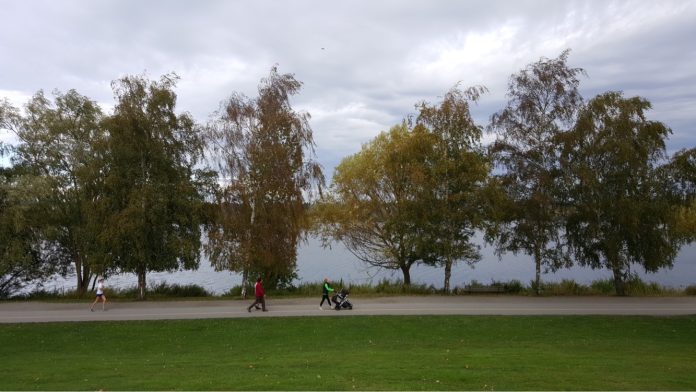The City of Seattle is currently near 60% design for paving and multi-modal improvements to major arterial streets in the Green Lake and Wallingford neighborhoods. The paving project will bring many improvements in alignment with the City’s 2014 Bicycle Master Plan and other city policies, including:
-
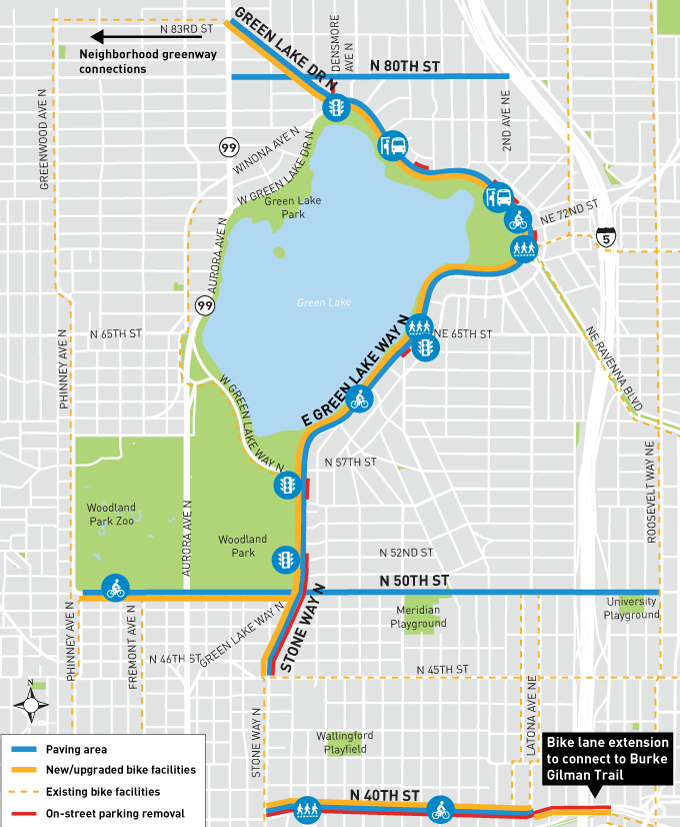
SDOT’s proposed improvements. (City of Seattle) New protected bike lanes on Green Lake Drives/Ways and Stone Way from Aurora Avenue to N 45th St. A two-way protected bike lane will follow along the parks and the north and south segments will have two one-way protected bike lanes.
- An uphill protected bike lane and downhill marked “sharrows” on N/NE 40th St from Stone Way N to 7th Ave NE.
- New bus bulbs at the bus stops along East Green Lake Drive.
- New traffic signals at three intersections, including at the north-end of the lake near Duke’s Chowder House, at the south-end of the lake near the Green Lake Pitch & Putt, and at Green Lake Way and N 52nd St.
In anticipation of this important project, caring neighbors formed “Green Lake & Wallingford Safe Streets,” now a member organization of the Seattle Neighborhood Greenways coalition with more than 300 supporters.
Overall, these are good improvements. We believe they can improve the street designs even more to implement Vision Zero and the Bicycle Master Plan, provide safe routes to parks and schools, and create a park and trail-like experience that’s just as much a regional draw and neighborhood asset as the parks themselves.
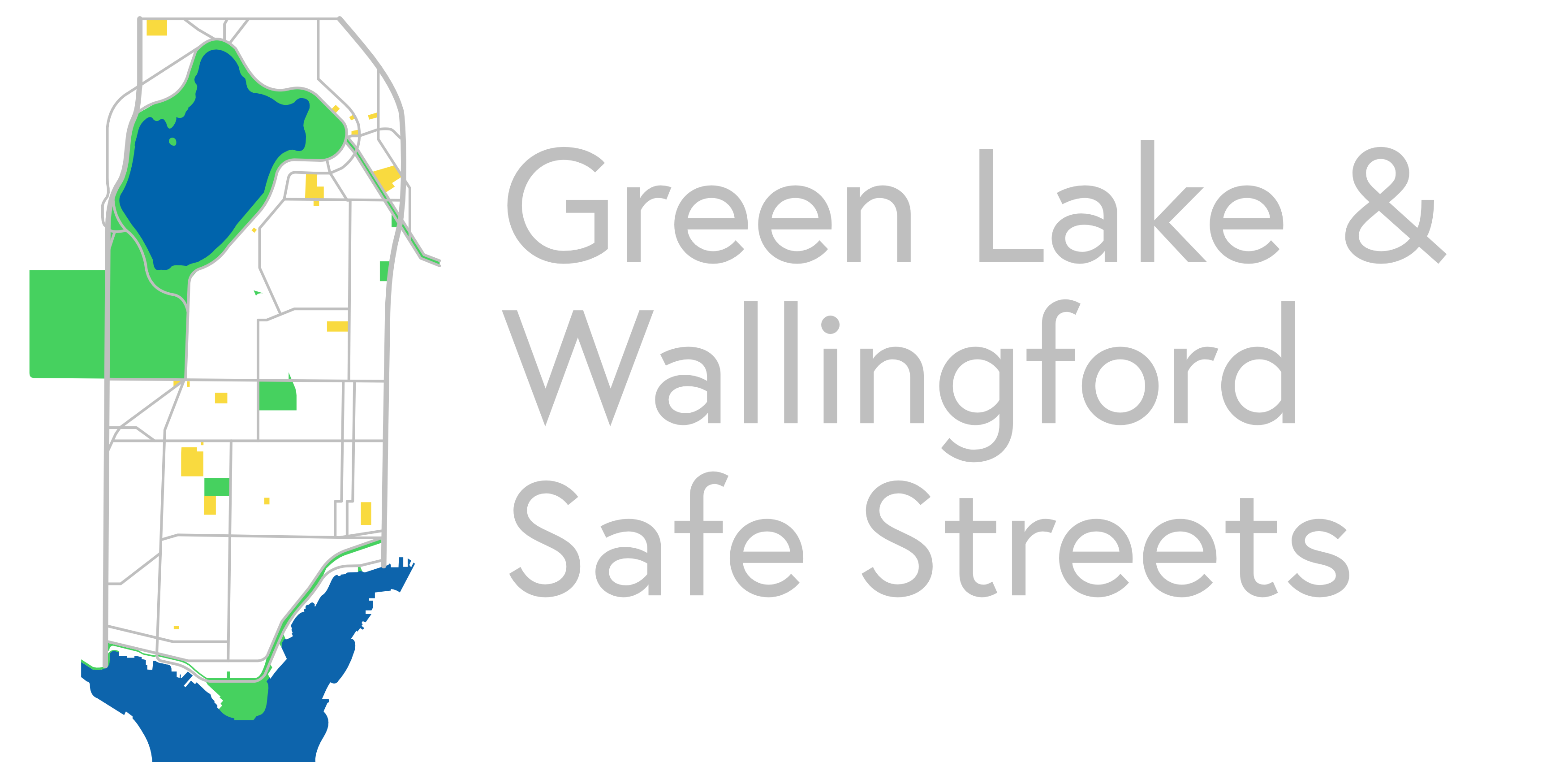
Thousands of people walk, stroll, run, bike, swim, and row in Green Lake and Woodland Parks every weekend and even weekdays. Getting to and through our parks should be just as safe, comfortable, and wonderful as our parks themselves. The addition of the two-way protected bike lane is effectively an addition of a new bike path around the entire east-side of Green Lake Park. Now, let’s make it even better.
Here are our two major priorities:
- A: Square-up the intersection at Ravenna Boulevard; and
- B: Extend the two-way protected bike lane to N 50th St and create a protected phase for people biking southbound.
If you like what you see, join us in support by signing our petition. You can also see our proposals in greater detail on our website.
All graphics below were illustrated by Brock Howell. The 30% designs were based on engineering documents from SDOT, but may contain inaccuracies. The Seattle Department of Transportation (SDOT) now has new 60% engineering documents, which the illustrations do not reflect, although are not significantly different.
Priority A: Square-up the intersection at Ravenna Boulevard
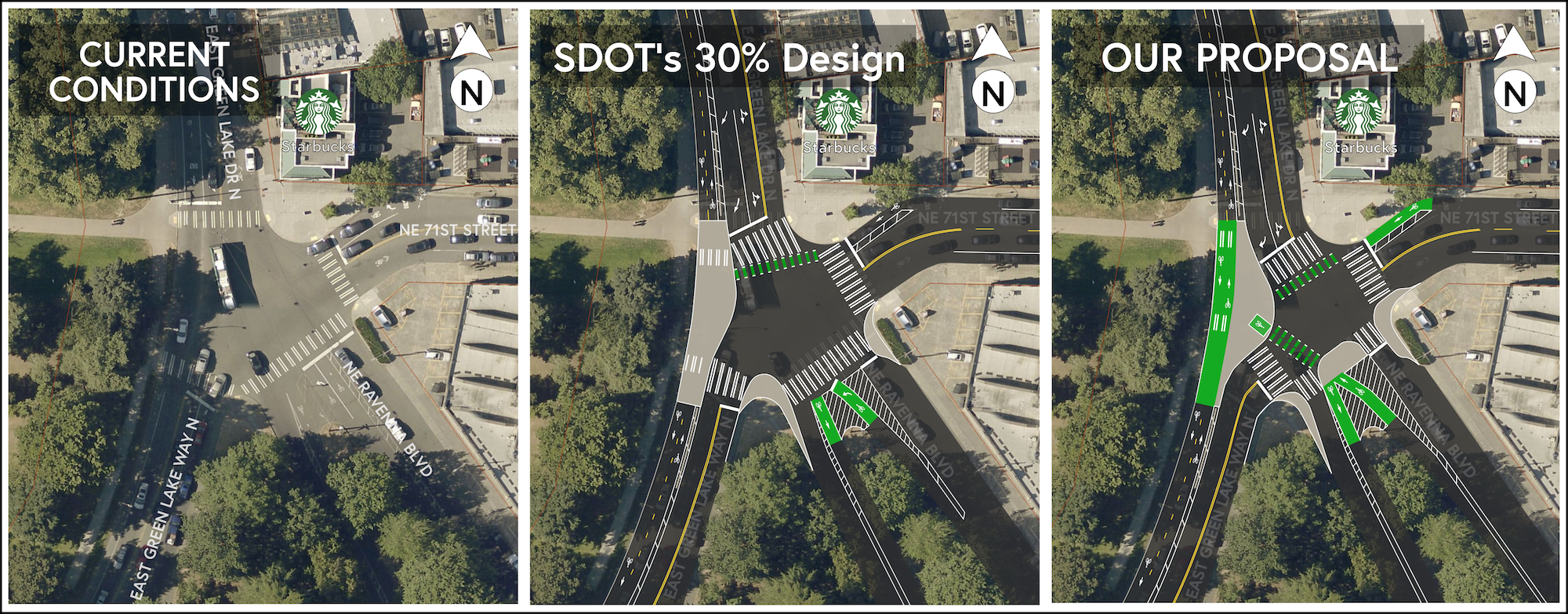
The intersection of East Green Lake Drive, NE 71st St, NE Ravenna Blvd, and East Green Lake Way, near the Starbucks is exceptionally wide, creating confusion by people driving and biking as to who has the right-of-way and requiring unnecessarily long crossings for people walking.
The intersection also acts as the main entrance into Green Lake Park with the most foot traffic into the park. In addition, El Esquelita Bilingual School, Billings Middle School, and the Green Lake Preschool in the Green Lake Community Center are all near this intersection.
The City’s 30% design would add a two-way protected bike lane around the park, eliminate two motor vehicle right-hand turn lanes (on East Green Lake Way and NE 71st St), and create new, relatively small, concrete curb bulbs. The City’s 60% design shows the city will also add crossbikes next to all crosswalks. These are good improvements over the current conditions.
We believe the intersection should be “squared-up” even more than the City’s current design, making the turning motion from East Green Lake Drive to East Green Lake Way more of a true right-hand turn, and aligning East Green Lake Way with NE 71st St and aligning East Green Lake Way with Ravenna Boulevard as straight-through streets. This can be achieved by extending the planned new curb bulbs and adding a concrete island at the end of Ravenna Boulevard. In addition, clearly marking the two-way protected bike lane and crossbike to and from Ravenna Boulevard will help drivers and pedestrians know where to expect bicyclists.
Benefits:
- Reduces confusion by drivers and others as to who has the right-of-way (whose turn it is to cross the intersection);
- Shortens crossing distances for people walking, biking, and driving;
- Creates more waiting space for pedestrians;
- Creates a larger entrance into Green Lake Park;
- Reduces conflicts between people biking and people walking and driving by clearly marking the protected bike lane and crossbike; and
- Provides placemaking opportunity for planters, a bench, or art within enlarged curb bulb adjacent to park.
Priority B: Extend the two-way protected bike lane to N 50th St and create a protected phase for people biking southbound
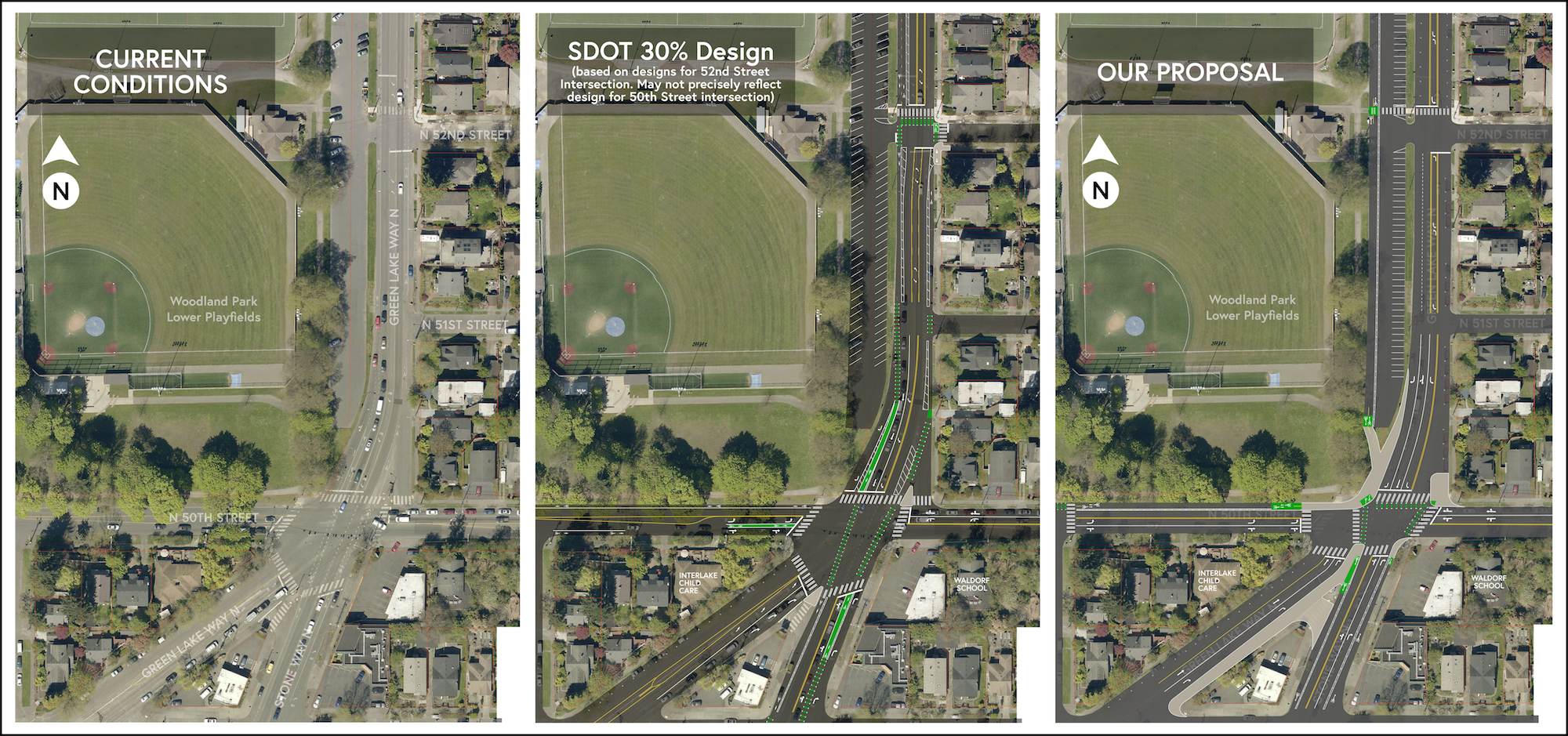
The intersection of Green Lake Way N, Stone Way N, and N 50th St is considered one of the worst in the city for people walking, biking and driving, which is especially bad considering the Woodland Park Lower Playfields are heavily used and Interlake Child Care and Seattle Waldorf School are both directly adjacent.
From drivers’ standpoint, SDOT considers the intersection to have a “Level of Service F”–failing. Although SDOT doesn’t grade intersection experiences for people not in cars, this intersection is also failing people walking and biking. From a pedestrian standpoint, it takes two entire traffic signal cycles to simply cross the streets from the northwest corner at Woodland Park to the southern corner with Kidd Valley Burgers. For people biking, the intersection is incredibly wide and the bike lanes are squeezed between motor vehicle turn lanes, creating risky maneuvers to get properly positioned at the intersection. So it’s easy to see why the intersection was voted the worst in Seattle in 2016.
Unfortunately, the City currently plans to make no improvements to the intersection except to sync the traffic light with the new traffic lights at the N 52nd St and Pitch & Putt intersections.
We believe a minor adjustment to the signal timing at the N 50th St intersection can unlock major improvements. Unlike all other vehicle lanes at the intersection, the right-hand turn lane on Green Lake Way coming southbound from Green Lake Park has two green phases:
- When the vehicles on Green Lake Way westbound and northbound from Aurora Avenue have a green phase; and
- When the vehicles in the middle lanes on Green Lake Way southbound and westbound from Green Lake Park have a green phase.
Our proposal would eliminate the second green phase.
Eliminating the second green phase for the right-turning lane would enable the extension of the two-way protected bike lane from N 52nd St to N 50th St and the creation of a protected crossing for people biking and walking. People walking would also be able to cross in a single light cycle from the northwest corner at Woodland Park to the Kidd Valley block.
The light signal change also enables the two-way protected bike lane to be routed along the western edge of the Woodland Park Lower Playfields Parking Lot, which would eliminate three driveway crossings for the protected bike lane. And it enables the creation of a two-way protected bike lane on N 50th St from Fremont Ave N to Green Lake Park.
For people biking northbound from Stone Way towards Green Lake Park, they would cross similarly to what SDOT currently has planned for N 52nd St: they would make a two-stage turn to get into the two-way protected bike lane, taking advantage of the intersection’s counter-clockwise green phasing to cross at the very next cycle.
Benefits:
- Enables the extension and addition of new two-way protected bike lanes;
- Significantly improves pedestrian experience;
- Possibly shortens crossing distances;
- Eliminates the need for a new traffic signal at N 52nd St, saving around $500,000; and
- Enables the retention and addition of motor vehicle parking adjacent to the homes along Green Lake Way between N 50th St and N 52nd St.
What’s also possible with Priority B

Rather than putting the two-way protected bike lane on Green Lake Way from the Pitch & Putt intersection (south-end of Green Lake Park) to N 52nd St, we strongly support putting the two-way protected bike lane on the western edge of the Woodland Park Lower Playfields Parking Lot.
Located on the western edge of the parking lot, the two-way protected bike lane would not cross three driveways, could be as wide as 14 feet with a larger buffer, and would create an exceptional trail-like experience through Woodland Park and to Green Lake Park. In concept, it would be similar to the Westlake Cycletrack, but with less pedestrian traffic.
By changing the parking lot’s eastern-side vehicle parking from diagonal to perpendicular parking (which is more space efficient), and adding new parking along Green Lake Way, there would be no net loss of vehicle parking. Shifting the bike lane off of Green Lake Way would also enable the retention and addition of vehicle parking directly adjacent to the homes between N 52nd St and N 50th St.
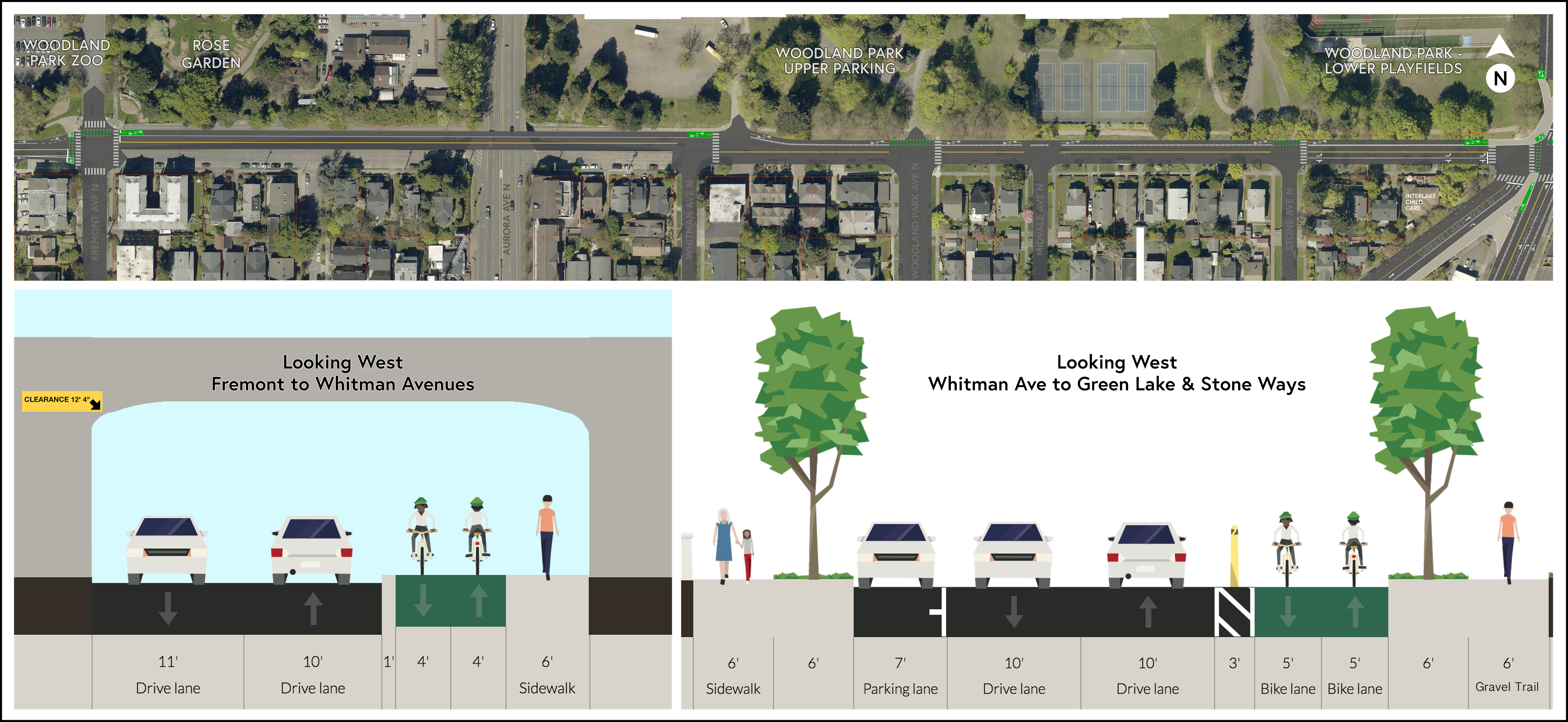
The 2014 Bicycle Master Plan calls for protected bike lanes on N 50th St from Phinney Ave N to Green Lake Way N. Because the City does not plan to change the traffic signalization of the intersection at Green Lake Way N and Stone Way N, the City does not plan to build the BMP’s prioritized protected bike lanes for N 50th St. We believe this is the wrong approach, and with the minor traffic signal change we’re proposing, the City can build the protected bike lane.
N 50th St is exceptionally uncomfortable for people to bike downhill from Fremont Ave N to Green Lake Way. First, it has narrow bike lanes directly up against a large concrete retaining wall as N 50th St goes under Aurora Avenue. At Whitman Ave N, the bike lane has a blind intersection as drivers from the right come down the hill from Aurora Avenue. Then, there’s the door zone bike lane from Whitman Ave N to Stone Ave N and, finally, between Stone Ave N and Green Lake Way, people biking must merge across a motor vehicle lane to get into a suicide bike lane at the intersection in order to make a left-hand turn to head north on Green Lake Way towards Green Lake Park. It’s dangerous.
With a new protected crossing at the intersection of Green Lake Way and Stone Way and the extension of a two-way protected bike lane on Green Lake Way to N 50th St, there’s no longer any reason for the current configuration of N 50th St. Instead, there could be a two-way protected bike lane on N 50th St from Fremont Ave N to Green Lake Way on the north side of the street, along Woodland Park. Much of it would be ten feet wide with a three-foot buffer. As N 50th St goes underneath Aurora from Fremont Ave N to Whitman Ave N, the roadway is more constrained and therefore the protected bike lane would be narrower and would need to be raised to sidewalk level.
The new two-way protected bike lane on N 50th St would have just have just one significant driveway crossing, no doorzones, no blind intersections, and no merges across motor vehicle lanes. It would also seamlessly merge into the two-way protected bike lane on Green Lake Way, which would be ideally routed through the western edge of the Woodland Park Lower Playfields Parking Lot.
Does our proposal excite you? Read more about our recommendations on our website and sign our petition.
Brock Howell
Brock Howell has worked on transportation and land use policy the last decade in the Pacific Northwest, including at Futurewise and Cascade Bicycle Club. He currently works with Seattle For Everyone and has his own consulting business, Howell Consulting.

